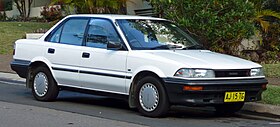| Toyota Corolla (E90) | |
|---|---|
 Pre-facelift Toyota Corolla CS sedan | |
| Overview | |
| Manufacturer | Toyota |
| Model code | E90 |
| Also called |
|
| Production |
|
| Model years | 1988–1992 |
| Assembly |
|
| Designer | Seiiji Fukushima (1984)[2] |
| Body and chassis | |
| Body style |
|
| Layout | Front engine, front-wheel-drive / four-wheel-drive |
| Powertrain | |
| Engine | |
| Transmission | |
| Dimensions | |
| Wheelbase | 2,431 mm (95.7 in) |
| Length |
|
| Width |
|
| Height |
|
| Curb weight | 880–1,200 kg (1,940–2,646 lb) |
| Chronology | |
| Predecessor |
|
| Successor | Corolla E100 |
The Corolla E90 was the sixth generation of cars sold by Toyota under the Corolla nameplate, introduced in 1987 for the 1988 model year. It was the last generation of Corolla to be classified as a subcompact car and the first to be exclusively front-wheel drive or all-wheel drive;[3] the performance option of rear-wheel drive was dropped.
For general export, the trim levels were Base, XL, GL, SE, and SE Limited. The GT-i (known as the SX Seca and/or Hatch in Australia) was a high-performance model powered by the 4A-GE engine; it was offered with hatchback and also five-door liftback bodywork in some markets. The North American GT-S coupé shared the same engine. The all-wheel drive Sprinter Carib wagon used a beam axle rear suspension with coil springs, while the rest used struts all around. In South Africa, the E90 was manufactured and marketed by Toyota under the Carri, Conquest, and Tazz model names. In a pair of similar joint ventures with General Motors, E90 variants with minor cosmetic changes were locally manufactured and sold as the Geo Prizm and Holden Nova in the United States and Australia respectively.
The majority of the Corolla range was replaced in June 1991 for the Japanese market, but production for export markets continued into 1992, and Australian Holden production extended until mid 1994. The all-wheel drive wagon was sold from 1988 to 1994 and had different bodywork to other Corollas; it replaced the Tercel 4WD Wagon/Sprinter Carib in Toyota's lineup. It retained the Sprinter Carib name in Japan, but was marketed as the Corolla Touring in Europe and some other countries, and as the Corolla All-Trac in the United States.
- ^ "Overview of Overseas Production Affiliates: Oceania". Toyota Motor Corporation. 2012. Retrieved 11 July 2014.
- ^ "Patent 0732102, S". Japan. 18 January 1991. Retrieved 15 June 2019.
- ^ "Toyota Passenger Car Chronology" (Press release). U.S.: Toyota. 29 March 2016. Retrieved 17 June 2019.